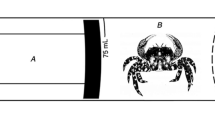Abstract
Large-sized Daphnia hyalina×galeata hybrid and small-sized Ceriodaphnia reticulata were raised together for 3 weeks in thermally stratified flow-through tubes ('plankton organ'), in the presence and the absence of fish kairomone, and their relative performance was monitored, as indicated by the populations' growth rates (r). In the kairomone-free medium, D. hyalina grew faster than C. reticulata; the presence of kairomone reversed this ratio, producing relatively higher r in C. reticulata. The simulated fish presence reduced growth in D. hyalina population also when it was separated from the competitor, while growth in C. reticulata was altered by the kairomone only in the presence of Daphnia. It is suggested that costs of surface avoidance in Daphnia can reduce its competitive superiority to small-sized cladocerans, permanently dwelling at the surface.
Similar content being viewed by others
References
Brooks, J. L. & S. I. Dodson, 1965. Predation, body size and composition of plankton. Science 150: 28-35.
Dawidowicz, P. & C. I. Loose, 1992. Metabolic costs during predator-induced diel vertical migration of Daphnia. Limnology and Oceanography 37: 1589-1595.
DeMeester, L., P. Dawidowicz, E. van Gool & C. J. Loose, 1998. Ecology and evolution of predator-induced behavior of zooplankton: Depth selection behavior and diel vertical migration. In Tollrian, R. & C. D. Harvell (eds), The Ecology and Evolution of Induced Defenses. Princeton University Press, Princeton, NJ: 160-177.
Gliwicz, Z. M., 1985. Predation or food limitation: an ultimate reason for extinction of planktonic cladoceran species. Arch. Hydrobiol. Beih. Ergebn. Limnol. 21: 419-430.
Gliwicz, Z. M., 1990. Food threshold and body size in cladocerans. Nature 343: 638-640.
Gliwicz, Z. M. & J. Pijanowska, 1989. The role of predation in zooplankton succession. In Sommer, U. (ed.), Plankton Ecology. Springer Verlag, Heidelberg, NY: 253-296.
Hrbaček, J., 1962. Species composition and amount of the zooplankton in relation to the fish stock. Rozpr. Česk. Akad. Ved, Rada Mat. Prir. Ved 10: 1-116.
Kreutzer, C. & W. Lampert, 1999. Exploitative competition in differently sized Daphnia species. A mechanistic explanation. Ecology 80: 2348-2357.
Lampert, W., 1978. A field study on the dependence of fecundity of Daphnia sp. on food concentration. Oecologia 36: 363-369.
Loose, C. J. & P. Dawidowicz, 1994. Trade-offs in diel vertical migration by zooplankton: the costs of predator avoidance. Ecology 80: 2348-2357.
Pijanowska, J., 1993. Diel vertical migration in zooplankton: xed or inducible behaviour? Arch. Hydrobiol. Beih. Ergebn. Limnol. 39: 89-97.
Sommer, U., Z. M. Gliwicz, W. Lampert & A. Duncan, 1986. The PEG-model of seasonal succession of planktonic events in freshwaters. Archiv für Hydrobiologie 106.
Vos, M., B. J. G. Flik, J. Vijverberg, J. Ringelberg & W. M. Mooij, 2002. From inducible defences to population dynamics: modelling refuge use and life history changes in Daphnia. Oikos 99: 386-396.
Author information
Authors and Affiliations
Rights and permissions
About this article
Cite this article
Dawidowicz, P., Wielanier, M. Costs of Predator Avoidance Reduce Competitive Ability of Daphnia . Hydrobiologia 526, 165–169 (2004). https://doi.org/10.1023/B:HYDR.0000041606.80236.d6
Issue Date:
DOI: https://doi.org/10.1023/B:HYDR.0000041606.80236.d6




